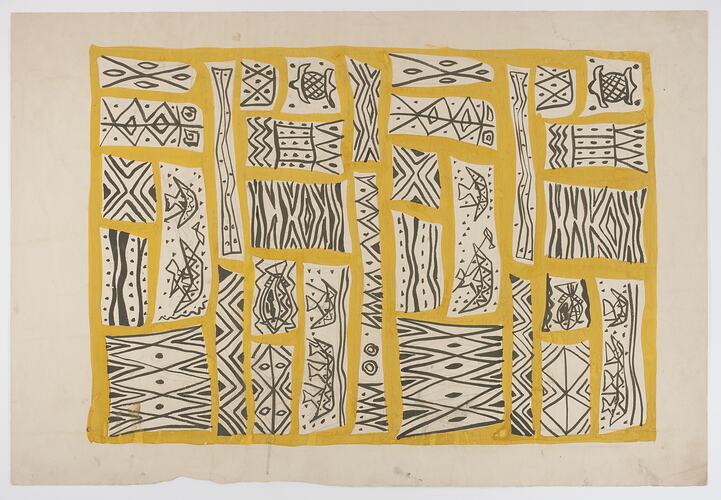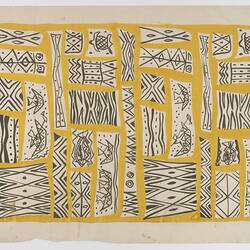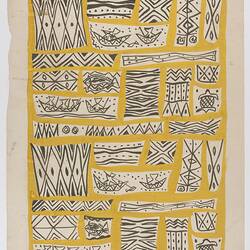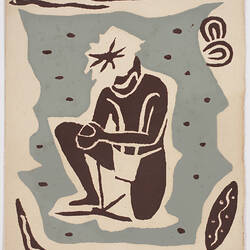Summary
Watercolour design in yellow and black on buff cloured paper, possibly for a tea towel. Geometric design with figures fishing in boats with fish and turtles. On the back there are some sketches in pencil of the designs.
John Rodriquez studied art and design at RMIT in the late 1940s and became well known for his screen-printed textile designs in the early 1950s. From 1950 to 1980 he was one of a handful of Australian textile designers who developed a new contemporary style with innovative use of colour. His designs in the early 1950s were mostly of Aboriginal or geometric style. Later he turned to more abstract designs in the Scandinavian style. Later still he made bold use of colour. Rodriquez introduced unique Australian styles which have been imitated often since. He always stressed the importance of innovation. Many homes in Australia and overseas still have his art works in the linen cupboard.
John Rodriquez retired in 1988, handing the Rodriquez company to his son Rimian, who has computerised the screen printing and mostly employs other designers for the products, but still uses a few of his father's most popular designs. Rodriquez passed away in 2000.
Physical Description
Yellow and black watercolour on buff cloured paper. Figures in boats with fish and turtles. Design sketches in pencil on reverse.
Significance
See Narrative 'John Rodriquez Textile Collection'.
The significance of this object lies, in part, in its use of Aboriginal imagery. The use of Australian motifs, including Aboriginal imagery, flora and fauna, became fashionable during the 1940s and 1950s. These motifs expressed a growing sense of Australian identity while the nation was experiencing the social upheavals of war and mass migration. Many immigrant artists also began to adopt these motifs as they settled into their new country. Aboriginal imagery expressed complex attitudes to Australia's first inhabitants: as culturally interesting, representing connection to place and landscape, yet signifying a distant, pre-civilised time, in contrast to modern Australia. The fact that much of the Aboriginal imagery was appropriated without permission or compensation was far from the thoughts of most commercial artists of the time.
More Information
-
Collection Names
-
Collecting Areas
-
Acquisition Information
Donation from Ms Patricia Rodriquez, 24 Jan 2006
-
Artist
-
Place & Date Made
-
Classification
-
Category
-
Discipline
-
Type of item
-
Overall Dimensions
380 mm (Width), 560 mm (Height)
-
Overall Dimensions - Rolled
560 mm (Length), 73 mm (Width)
Measurement From Conservation.
-
References
Photocopies of old issues of Home Beautiful which display John's fabric designs have been offered by the donor. Newspaper cuttings showing clothes made from Rodriquez-designed fabrics.
-
Keywords
Aboriginal Art, Artworks, Fabric Designs, Handcrafts, Textiles



